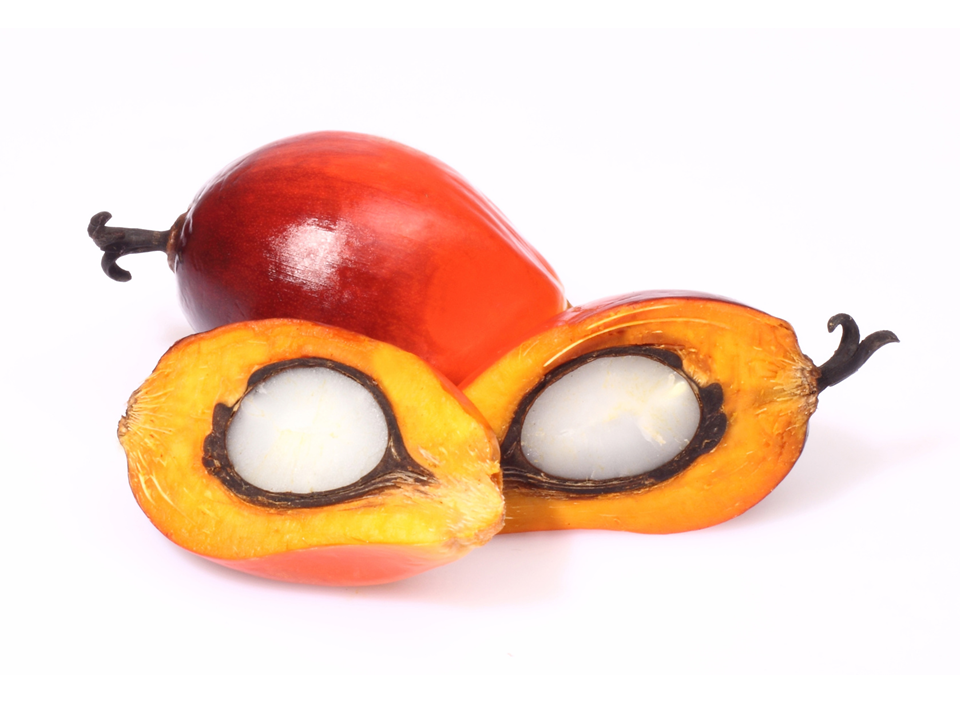
Palm oil (from the African palm oil, Elaeis guineensis) can be traced back to more than 5000 years ago. Palm oil was long recognized in West African countries. It is used widely among West African peoples as cooking oil. In the seventeenth century European merchants trading with West Africa occasionally purchased palm oil for use in Europe, but as the oil was bulky and cheap, and due to the much higher profits available from slave-trading, palm oil remained rare outside West Africa.
During the early nineteenth century, the decline of the Atlantic slave trade and Europe’s demand for legitimate commerce (trade in material goods rather than human lives) obliged African countries to seek new sources of trade revenue. In the Asante Confederacy, state-owned slaves built large plantations of palm oil trees, while in the neighboring Kingdom of Dahomey, King Ghezo passed a law in 1856 forbidding his subjects from cutting down palm oil trees.
Palm oil became a highly sought-after commodity by British traders, the oil being used as industrial lubricant for the machines of Britain’s ongoing Industrial Revolution, as well as forming the basis for various brands of soap such as Palmolive. By 1870, palm oil constituted the primary export of some West African countries such as Ghana and Nigeria. By the 1880s, cocoa had become more highly sought-after, leading to the decline of the palm oil industry and trade within these countries.
5,000 വർഷങ്ങൾ പിറകോട്ട് പോയാൽ ചരിത്രത്തിൽ പാം ഓയിലിനെ നമ്മൾക്ക് കണ്ടെത്താൻ സാധിക്കും. പടിഞ്ഞാറൻ ആഫ്രിക്കൻ പ്രേദേശങ്ങളിലാണ് പാം ഓയിൽ കൂടുതലായും കണ്ടെത്തിയിട്ടുള്ളത്. അവർ ഇതിനെ പാചകത്തിനായിട്ടുള്ള എണ്ണയായിട്ടാണ് ഉപയോഗിച്ചിരുന്നത്. 17-כo നൂറ്റാണ്ടിൽ യൂറോപ്പിൽ നിന്ന് ആഫ്രിക്കയിൽ വന്ന കച്ചവടക്കാർ പാം ഓയിൽ അവരുടെ ആവശ്യത്തിനായി വാങ്ങിക്കുകയുണ്ടായി, വളരെ കുറഞ്ഞ വിലയിൽ കൂടുതൽ പാം ഓയിൽ വാങ്ങിച്ചു, പക്ഷെ അതിനേക്കാൾ കൂടുതൽ വരുമാനം അടിമ കച്ചവടത്തിൽ നിന്ന് കിട്ടുന്നതുകൊണ്ട് പടിഞ്ഞാറൻ ആഫ്രിക്കയ്ക്ക് പുറമേ പാം ഓയിലിന് വിപണി കണ്ടെത്താൻ സാധിച്ചില്ല.
The palm oil, Elaeis guineensis is not native to Malaysia. Palm oil was first introduced to Malaysia (then Malaya) in 1870 as an ornamental plant. Its use as a crop was developed in 1917 when the first plantation was established. Then the palm oils plantation was mostly operated by English landowners. From the 1960’s major palm oil plantation scheme was introduced by the government mainly to eradicate poverty. Each settler was allocated 10 acres of land planted either with Palm oil or rubber, and they are given 20 years to pay off the land.
Malaysia is the largest exporter of palm oil in the world, producing about 15 million tonnes of palm oil a year. It now accounts for approximately 47% of global palm oil production and 54% of world exports. As one of the biggest producer and exporter of palm oil and palm oil products, Malaysia has been playing an important role to accomplish the needs and to stay competitive in the world’s oils and fats market. In 2004, Malaysia produced nearly 14 million tones of palm oil, from its mere 3.8 million hectares of plantation area. This has contributed to more than 1/3 of the agricultural GDP or 2.9% of the national GDP. The sector has become of the most crucial foreign exchange earners for Malaysia.
19-כо നൂറ്റാണ്ടിന്റെ ആദ്യ കാലഘട്ടത്തിൽ അറ്റ്ലാന്റിക് അടിമ കച്ചവടം കുറഞ്ഞു കൊണ്ടിരിക്കുന്ന സമയത്ത് യുറോപ്യക്കാർ ന്യായമായ വാണിജ്യത്തിന് ആഹ്വാനം ചെയ്തു (മനുഷ്യർ ഒഴികെയുള്ള സാധങ്ങളുടെ വിൽപ്പന) ഇത് ആഫ്രിക്കൻ രാജ്യങ്ങളെ പുതിയ വാണിജ്യ വസ്തുക്കളെ കണ്ടെത്തുന്നതിലേക്കു നയിച്ചു. സംസ്ഥാനത്തിന്റെ ഉടമസ്ഥതയിലുള്ള അടിമകളുടെ കൂട്ടായ്മയിലൂടെ രാജ്യത്ത് ധാരാളം ഓയിൽ പാം ചെടികളുടെ കൃഷി ആരംഭിച്ചു, 1856-ൽ ആഫ്രിക്കൻ അയൽ രാജ്യമായ ദഹോമേയിലെ രാജാവ് ഗീസോ തൻറെ നിയമങ്ങളിൽ നിന്ന് ഓയിൽ പാം ചെടികളെ വെട്ടി നശിപ്പിക്കുന്നത് ഒഴിവാക്കി. ബ്രിട്ടനിൽ വ്യാവസായിക വൽക്കരണം നടക്കുന്ന കാലഘട്ടത്തിൽ മെഷിനുകളിൽ ഇൻഡസ്ട്രിയൽ ലൂബ്രിക്കന്റ് ആയി ഉപയോഗിച്ചിരുന്നത് പാം ഓയിൽ ആയിരുന്നു, അതുകൊണ്ടു തന്നെ ബ്രിട്ടീഷ് വ്യാപാരികൾക്ക് ഇത് ഒരു പ്രധാന വാണിജ്യ ഘടകമായി മാറി. ഇതിന്റെ അടിസ്ഥാനത്തിൽ പല സോപ്പുകളുടേയും പ്രധാന ഘടകം പാം ഓയിൽ ആയി മാറി (പല ബ്രാൻഡുകളും) ഉദാഹരണത്തിന് പാം ഓലിവ്. 1870-ൽ കിഴക്കൻ ആഫ്രിക്കൻ രാജ്യങ്ങളിൽ ഉദാഹരണത്തിന് ഖാന, നൈജീരിയ തുടങ്ങിവയിൽ പ്രാഥമിക കയറ്റുമതി
പാം ഓയിൽ ആയിരുന്നു. 1880- കളോടെ പാം ഓയിൽ വായണിജ്യം ഈ രാജ്യങ്ങളിൽ വ്യാപിച്ചു.
പാം ഓയിൽ, Elaeis guineensis എന്ന ചെടിയുടെ ജന്മസ്ഥലം മലേഷ്യയല്ല. 1870-ൽ ഇതിനെ മലേഷ്യയിൽ പരിചയപ്പെടുത്തിയത് ഒരു ആഭരണ സസ്യമായിട്ടാണ്. ഇത് ഒരു ധാന്യ വിളയായി രൂപകൽപ്പനപ്പെടുത്തിയത് 1917-ലാണ്. പാം ഓയിലിന്റെ കൃഷി പ്രധാനമായും നടത്തിയിരുന്നത് വിദേശ ഭൂഉടമകളായിരുന്നു. 1960-ലാണ് ഗവൺമെന്റ് ദാരിദ്ര്യ നിർമ്മാർജനത്തിനായി പ്രധാനപ്പെട്ട പാം ഓയിൽ നടീൽ പദ്ധതി നടപ്പിലാക്കുന്നത്. ഓരോ ഭൂഉടമസ്ഥനും സമ്മതിച്ചു അവരവരുടെ പക്കൽ നിന്നും 10 ഏക്കർ സ്ഥലം റബ്ബർ നടുന്നതിനോ ഓയിൽ പാം കൃഷി ചെയ്യുന്നതിനോ ആയി നൽകുവാൻ. ഏകദേശം 20 വര്ഷങ്ങളോളം വേണ്ടി വന്നു അവർക്ക് അത് തിരികെ ലഭിക്കാൻ. ലോകത്തിലെ ഏറ്റവും വലിയ പാം ഓയിൽ എക്സ്പോർട്ടർ മലേഷ്യ ആണ്. ഏകദേശം 15 മില്യൺ ടൺ എണ്ണയാണ് ഒരു വർഷം കയറ്റുമതി ചെയ്യുന്നത്, ഏകദേശ കണക്കനുസരിച് ഗ്ലോബൽ പാം ഓയിൽ ഉൽപ്പാദനത്തിന്റെ 47% ഉം കയറ്റുമതിയിൽ ലോകത്തിലെ 54% ഉം. പാം ഓയിലിന്റെയും ഓയിൽ ഉൽപ്പന്നങ്ങളുടെയും കയറ്റുമതിയും ഉൽപ്പാദനവും ഏറ്റവും കൂടുതൽ ചെയ്യുന്നതുകൊണ്ട് മലേഷ്യ ഈ മേഖലയിൽ പിടിച്ചു നിൽക്കാൻ ശ്രമിക്കുന്നു. 2004 -ൽ 3.8 ഹെക്ടർ കൃഷിസ്ഥലത്ത് നിന്ന് 14 മില്യൺ ടൺ പാം ഓയിലാണ് മലേഷ്യ ഉൽപ്പാദിപ്പിച്ചെടുത്തത്. കാർഷിക മേഖലയിലെ ആഭ്യന്തര ഉൽപ്പാദന വളർച്ചയുടെ (GDP) 1/3 ഉം രാജ്യത്തെ ആഭ്യന്തര ഉൽപ്പാദന വളർച്ചയുടെ (GDP) 2.9% ഉം ഉൽപ്പാദനം മലേഷ്യയാണ്. വിദേശ നാണ്യം ലഭിക്കുന്നതിനുള്ളഒരു പ്രധാന മാർഗമായിട്ടാണ് മലേഷ്യ പാം ഓയിലിനെ കാണുന്നത്.

